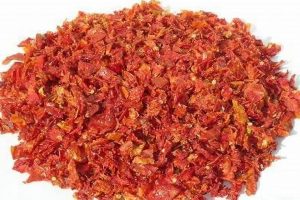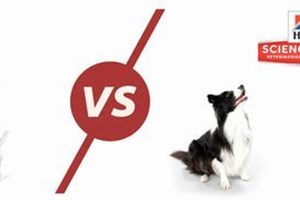This nutrient, often included as an additive in canine diets, is a water-soluble essential vitamin-like compound. Functionally, it plays a vital role in various physiological processes. For instance, it is involved in the synthesis of acetylcholine, a neurotransmitter crucial for nerve function and muscle control. Furthermore, it contributes to the structure and function of cell membranes as a precursor to phosphatidylcholine and sphingomyelin.
Its inclusion in pet food formulations is paramount for ensuring optimal health and well-being. Adequate levels are necessary for supporting healthy brain function, preventing liver damage due to fat accumulation (hepatic lipidosis), and promoting efficient metabolism. Historically, its importance has been recognized through nutritional research highlighting deficiencies and their adverse effects on animal health.
Therefore, a comprehensive understanding of its role, its regulation, and its presence in commercial products is essential for informed pet owners and veterinary professionals. Subsequent sections will delve into the specific functions, regulatory aspects, sources, potential deficiencies, and other considerations related to this crucial nutrient in canine nutrition.
Choline Chloride in Canine Diets
The following guidelines provide essential information regarding the role and management of this nutrient in canine nutrition, aiming to promote optimal health and well-being.
Tip 1: Verify the Presence of Choline Chloride on the Ingredient List. Inspect dog food labels to ensure this compound is listed. Its absence may indicate a formulation lacking in sufficient levels of this essential nutrient.
Tip 2: Consider Life Stage and Activity Level. Puppies, pregnant or lactating females, and highly active dogs typically have increased requirements. Consult with a veterinarian to determine if supplementation is necessary.
Tip 3: Recognize Potential Deficiency Symptoms. While rare in commercially formulated diets, signs may include lethargy, impaired cognitive function, and liver problems. Prompt veterinary attention is crucial if these symptoms are observed.
Tip 4: Understand the Bioavailability of Different Forms. While supplementation is possible, the chloride salt is commonly used in commercial products due to its stability and cost-effectiveness.
Tip 5: Be Aware of Potential Interactions. Certain medications or health conditions may influence the absorption or utilization of this substance. Discuss any concerns with a veterinary professional.
Tip 6: Store Dog Food Properly. Exposure to heat, light, and moisture can degrade the nutrient content of dog food, including this compound. Store food in a cool, dry place in its original packaging.
Tip 7: Adhere to Feeding Guidelines. Overfeeding or underfeeding can disrupt the balance of nutrients, including this important component. Follow the manufacturer’s recommendations, adjusting as needed under veterinary guidance.
Following these tips contributes to ensuring adequate intake and appropriate management of this crucial nutrient, supporting optimal canine health and well-being.
The concluding section will summarize the overall significance of this additive and provide final recommendations for pet owners and veterinary professionals.
1. Essential nutrient
The designation of this compound as an essential nutrient underscores its indispensable role in maintaining canine health. Unlike non-essential nutrients, canines cannot synthesize it in sufficient quantities to meet their physiological needs, necessitating its inclusion in their diet. Deficiency can lead to a cascade of adverse health outcomes, highlighting the critical importance of adequate dietary intake.
- Metabolic Processes
This compound participates in numerous metabolic pathways, including lipid transport and metabolism. It assists in exporting triglycerides from the liver, preventing the accumulation of fat and averting hepatic lipidosis. Without sufficient levels, these processes are impaired, potentially leading to liver dysfunction.
- Neurotransmitter Function
It serves as a precursor for acetylcholine, a neurotransmitter involved in nerve impulse transmission and muscle control. Adequate amounts ensure efficient neural communication, supporting cognitive function and motor coordination. Deficiencies can manifest as impaired learning and memory.
- Cell Membrane Structure
It contributes to the synthesis of phospholipids, essential components of cell membranes. Phosphatidylcholine, a major phospholipid, maintains the integrity and fluidity of cell membranes. This structural role impacts overall cellular function and health. Insufficient intake can compromise cell membrane integrity.
- Growth and Development
Adequate intake is particularly crucial during periods of rapid growth and development, such as in puppies and pregnant or lactating females. It supports the formation of new cells and tissues, ensuring proper growth and development. Deficiencies during these critical periods can have long-lasting effects on health.
Given its involvement in diverse physiological processes, its inclusion in commercially formulated dog food is essential for meeting the nutritional needs of canines. Ensuring adequate dietary intake supports optimal metabolic function, neurological health, and overall well-being. Furthermore, its role highlights the importance of informed pet ownership and the necessity of selecting nutritionally complete and balanced diets.
2. Liver function
The liver, a vital organ responsible for numerous metabolic processes, is significantly influenced by the presence of this nutrient within canine diets. One of its primary roles is to facilitate the transport of fats from the liver. Without adequate amounts of this compound, triglycerides accumulate within the liver cells, leading to a condition known as hepatic lipidosis, or fatty liver disease. This accumulation disrupts normal liver function and can progress to more severe liver damage, including inflammation and cirrhosis. A diet deficient in it, therefore, directly compromises hepatic health.
Consider, for instance, a dog consuming a home-prepared diet lacking proper supplementation. Over time, this deficiency can result in the gradual buildup of fat within the liver. Early symptoms may include lethargy, loss of appetite, and vomiting. If left untreated, this condition can become life-threatening. Conversely, commercially formulated dog foods, by incorporating the right amount of this additive, actively support the liver’s ability to process and eliminate fats, thereby preventing the onset of hepatic lipidosis. Moreover, this compound contributes to the synthesis of phosphatidylcholine, a phospholipid vital for the structure and function of hepatocyte (liver cell) membranes, further enhancing liver health.
In conclusion, the link between this additive in canine nutrition and liver function is critical. Ensuring adequate dietary intake of this compound is essential for maintaining hepatic health and preventing the development of liver-related disorders. This understanding underscores the importance of selecting nutritionally balanced dog foods and, when necessary, consulting with a veterinarian regarding potential supplementation, particularly for dogs with pre-existing liver conditions or those consuming home-prepared diets.
3. Neurotransmitter synthesis
The synthesis of neurotransmitters, particularly acetylcholine, is directly reliant on the availability of this additive. Acetylcholine, a critical neurotransmitter involved in nerve impulse transmission and muscle function, requires choline as a precursor. The enzyme choline acetyltransferase catalyzes the reaction between choline and acetyl-CoA to produce acetylcholine. Insufficient dietary intake of this compound directly limits the production of acetylcholine, potentially leading to impaired neurological function. The presence of this compound in canine diets ensures an adequate supply of choline for this vital synthesis process.
Consider the impact of this relationship on cognitive function. Acetylcholine plays a significant role in memory and learning. Deficiencies in this neurotransmitter, stemming from inadequate choline availability, can manifest as cognitive decline. Older dogs, in particular, may experience improved cognitive performance with diets supplemented with this compound. Conversely, insufficient dietary intake could exacerbate age-related cognitive decline. Muscle function is also affected. Acetylcholine is essential for neuromuscular transmission. Deficiencies could lead to muscle weakness or incoordination. The presence of this additive in dog food therefore directly supports both cognitive and motor function.
In summary, the link between dietary choline, derived from this additive, and neurotransmitter synthesis is fundamental for canine neurological health. Adequate dietary intake of this additive ensures sufficient production of acetylcholine, supporting cognitive function, memory, and muscle control. Understanding this relationship is essential for selecting nutritionally complete dog foods that support optimal canine neurological well-being. Furthermore, recognizing potential signs of choline deficiency, such as cognitive decline or muscle weakness, can prompt appropriate dietary adjustments under veterinary guidance.
4. Cell membrane integrity
This compound’s influence on cell membrane integrity stems from its role as a precursor to phosphatidylcholine, a major phospholipid constituent of cell membranes. Phospholipids, arranged in a bilayer structure, form the fundamental framework of cell membranes, providing structural support and regulating the passage of substances into and out of cells. Without sufficient choline available, the synthesis of phosphatidylcholine is compromised, leading to weakened or dysfunctional cell membranes. These compromised membranes can exhibit increased permeability, reduced stability, and impaired signaling capabilities. The inclusion of this additive in canine diets, therefore, directly supports the synthesis of phosphatidylcholine, thereby bolstering cell membrane integrity.
Consider the implications for various tissues and organs. Healthy cell membranes are crucial for proper organ function. For example, in the liver, phosphatidylcholine ensures the structural integrity of hepatocyte membranes, facilitating efficient lipid metabolism. In the nervous system, it supports the membranes of nerve cells, enabling proper nerve impulse transmission. Furthermore, cell membrane integrity is essential for immune cell function, affecting the ability of immune cells to respond to pathogens effectively. A deficiency of this nutrient and subsequent compromise of cell membrane structure can, therefore, have widespread effects throughout the body. Ensuring adequate intake via appropriately formulated dog food promotes optimal cell membrane function and overall cellular health.
In conclusion, the link between dietary this additive and cell membrane integrity is critical for canine health. By providing choline for phosphatidylcholine synthesis, this additive contributes directly to the strength, stability, and functionality of cell membranes throughout the body. This understanding underscores the importance of selecting canine diets that include adequate levels of this essential nutrient, supporting optimal cellular health and overall well-being. Moreover, veterinary professionals should consider choline status when addressing conditions related to impaired cellular function or membrane instability.
5. Dietary inclusion
The strategic addition of this compound to canine diets represents a deliberate intervention to address the nutritional needs of dogs. Its incorporation into commercial formulations is not arbitrary; rather, it reflects a recognition of its essential role in supporting various physiological functions and preventing deficiency-related health problems.
- Supplementation Levels
The quantity added to dog food is carefully calculated based on established nutritional guidelines and the specific needs of different life stages (puppy, adult, senior) and activity levels. These levels are typically expressed in milligrams per kilogram (mg/kg) of food. Excessively high levels are avoided to prevent potential adverse effects, while insufficient levels undermine the intended health benefits. Manufacturers rely on research and expert recommendations to determine appropriate supplementation levels.
- Ingredient Interactions
This compound’s stability and bioavailability can be influenced by other ingredients present in the food formulation. For example, certain minerals or processing methods may affect its absorption and utilization. Formulators must consider these potential interactions to ensure that the nutrient remains effective throughout the shelf life of the product. Understanding these interactions is vital for preserving its nutritional value.
- Bioavailability Considerations
While this chloride salt is a common and cost-effective source of choline, its bioavailability (the extent to which it is absorbed and utilized by the body) may vary depending on factors such as particle size and the presence of absorption enhancers. Researchers continue to investigate alternative choline sources and delivery methods to optimize bioavailability and enhance its efficacy in supporting canine health. Ongoing research seeks to improve absorption efficiency.
- Regulatory Oversight
The inclusion of this compound in dog food is subject to regulatory scrutiny by organizations such as the Association of American Feed Control Officials (AAFCO). These agencies establish guidelines and standards for nutrient content, ingredient safety, and labeling accuracy. Compliance with these regulations ensures that dog food products meet minimum nutritional requirements and are safe for canine consumption. Regulatory compliance is a cornerstone of quality assurance.
These interconnected facets of its dietary inclusion collectively underscore the complexity and importance of ensuring adequate dietary choline intake for dogs. From carefully calculated supplementation levels to vigilant regulatory oversight, each aspect contributes to safeguarding canine health and well-being through optimized nutrition. The presence of this additive in dog food is, therefore, a deliberate and scientifically informed practice designed to meet the specific nutritional needs of canines.
Frequently Asked Questions
The following questions address common concerns and misconceptions regarding the inclusion of this additive in commercially available canine diets.
Question 1: Why is choline chloride included in dog food?
Its inclusion addresses the essential nutritional needs of canines. Dogs cannot synthesize sufficient quantities of choline to meet their physiological requirements. Supplementation, therefore, ensures adequate levels for vital processes, including liver function, neurotransmitter synthesis, and cell membrane integrity.
Question 2: Is this additive safe for dogs to consume?
The additive is generally recognized as safe (GRAS) for use in animal feed when used in accordance with established guidelines. Regulatory bodies, such as AAFCO, set limits and standards to ensure product safety. Nonetheless, excessive intake may lead to adverse effects; therefore, adherence to recommended feeding guidelines is crucial.
Question 3: Can a dog receive too much from its diet?
While deficiencies are more common, excessive intake is theoretically possible. However, commercially formulated dog foods are typically designed to provide balanced nutrition within safe limits. Concerns regarding overconsumption should be addressed with a veterinarian, particularly if the dog is also receiving additional choline supplements.
Question 4: Are there any specific health conditions that warrant increased intake?
Certain health conditions, such as liver disease or cognitive dysfunction, may benefit from increased dietary intake. However, any dietary modification should be undertaken under the guidance of a veterinarian. Self-supplementation without professional advice is discouraged.
Question 5: How can a pet owner determine if a dog food contains an adequate amount of this additive?
Examine the ingredient list on the dog food label. Its presence indicates that it has been added. The guaranteed analysis may provide further information on its concentration. Consulting the manufacturer’s website or contacting their customer service department may also provide additional details.
Question 6: Are there alternative sources of choline besides that particular chloride salt?
While this additive is a common source, other choline-containing compounds, such as phosphatidylcholine and lecithin, can also contribute to dietary choline intake. These sources may be present in ingredients like eggs, liver, and soybeans. However, the chloride form is often preferred in commercial formulations due to its stability and cost-effectiveness.
This frequently asked questions section provided insights regarding this additives importance in canine diet. A general overview of the topic from safety perspective is reviewed.
The subsequent section will provide a concluding summary, reinforcing the key benefits of, and considerations concerning, this nutrient in canine nutrition.
Conclusion
The preceding analysis has underscored the significance of this additive in canine nutrition. Its multifaceted role, spanning liver function, neurotransmitter synthesis, and cell membrane integrity, establishes it as an indispensable component of a balanced canine diet. Commercial dog food formulations incorporating this compound aim to mitigate the risks associated with choline deficiency and promote optimal physiological function. However, a nuanced understanding of individual canine needs, potential ingredient interactions, and proper storage practices remains paramount for maximizing its benefits.
The long-term implications of choline nutrition for canine health warrant continued investigation. Pet owners and veterinary professionals are encouraged to remain informed about ongoing research and evolving dietary recommendations. Thoughtful consideration of the choline content in canine diets, coupled with proactive monitoring of canine health, represents a responsible approach to ensuring optimal well-being and longevity.







